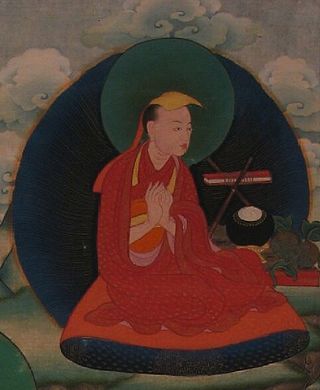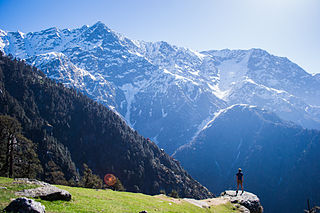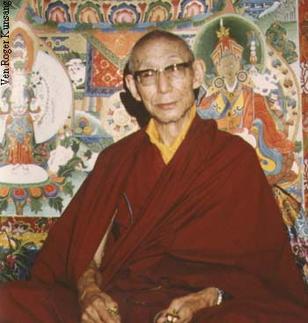
Sonam Gyatso was the first to be named Dalai Lama, although the title was retrospectively given to his two predecessors.

Bodh Gayā is a religious site and place of pilgrimage associated with the Mahabodhi Temple Complex, situated in the Gaya district in the Indian state of Bihar. It is famous for being the place where Gautama Buddha is said to have attained Enlightenment under what became known as the Bodhi Tree. Since antiquity, Bodh Gaya has remained the object of pilgrimage and veneration, for Hindus and Buddhists both. In particular, archaeological finds, including sculptures, show that the site was in use by Buddhists since the Mauryan period.

The Ganden Tripa, also spelled Gaden Tripa, is the title of the spiritual leader of the Gelug school of Tibetan Buddhism, the school that controlled central Tibet from the mid-17th century until the 1950s. The 103rd Ganden Tripa, Jetsun Lobsang Tenzin, died in office on 21 April 2017. Currently, Jangtse Choejey Kyabje Jetsun Lobsang Tenzin Palsangpo is the 104th Ganden Tripa.

Tibetan Children's Villages or TCV is an integrated community in exile for the care and education of orphans, destitutes and refugee children from Tibet. It is a registered, nonprofit charitable organization with its main facility based at Dharamsala in Himachal Pradesh, North India. TCV has a network spread across India with over 12,000 children under its care.

GyutoTantric University is one of the great monastic institutions of the Gelug Order.
Namgyal Rinpoche, Karma Tenzin Dorje (1931–2003), born Leslie George Dawson in Toronto, Canada, was a Tibetan Buddhist lama in the Karma Kagyu tradition.

Nechung Monastery, Nechung Gompa or Nechung Chok, is the seat of the State Oracle of Tibet. It is also referred to as Sungi Gyelpoi Tsenkar, the "Demon Fortress of the Oracle King."

In religion and spirituality, a pilgrimage is a long journey or search of great moral significance. Sometimes, it is a journey to a sacred place or to a shrine of importance to a person's beliefs and faith. Members of every major religion participate in pilgrimages. A person who makes such a journey is called a pilgrim.

McLeod Ganj or McLeodganj is a suburb of Dharamshala in Kangra district, Himachal Pradesh, India. It is known as "Little Lhasa" or "Dhasa" as the Tibetan government-in-exile is headquartered here and there is a significant population of Tibetans in the region.
Namgyal Monastery Institute of Buddhist Studies incorporates two institutions: (1) the North American Seat of Namgyal Monastery; and (2) a Tibetan Buddhist theological seminary affiliated with it. The two institutions share a dharma center in Ithaca, New York. The Dalai Lama is their patron, the highest authority, and consultant.
Ganden Choeling Nunnery or Geden Chöling is a Tibetan Buddhist vihara for Buddhist nuns in Dharamshala, India. It is near the monastery in which the 14th Dalai Lama resides.
Khensur Denma Locho Rinpoche also known as Lobsang Oser Choying Gyatso, was a Tibetan incarnate lama, or tulku, of the Loseling College of Drepung Monastery. An expert on Yamantaka and Vajrayogini, he is considered an incomparable luminary of Je Tsongkhapa's lineage, is renowned as a holder of the Tantric lineages, a master of the Tantric yogas, and the lineage holder of Ling Rinpoche.

Losang Samten is a Tibetan-American scholar, sand mandala artist, former Buddhist monk, and Spiritual Director of the Chenrezig Tibetan Buddhist Center of Philadelphia. He is one of only an estimated 30 people worldwide who are qualified to teach the traditional art of Tibetan sandpainting. He has written two books and helped to create the first Tibetan sand mandala ever shown publicly in the West in 1988. In 2002, he was made a National Heritage Fellow by the National Endowment of the Arts. In 2004, he was granted a Pew Fellowship in Folk and Traditional Arts.

Buddhism in the Himachal Pradesh state of India of has been a long-recorded practice. The spread of Buddhism in the region has occurred intermediately throughout its history. Starting in the 3rd century BCE, Buddhism was propagated by the Maurya Empire under the reign of Ashoka. The region would remain an important center for Buddhism under the Kushan Empire and its vassals. Over the centuries the following of Buddhism has greatly fluctuated. Yet by experiencing revivals and migrations, Buddhism continued to be rooted in the region, particularly in the Lahaul, Spiti and Kinnaur valleys.
There is a small Mongolian community in India, comprising mostly Buddhist monks and scholars as well as international students from Mongolia.

Kyabje Yongzin Ling Rinpoche is a Tibetan tulku. The best-known incarnation is the sixth incarnation, Thupten Lungtok Namgyal Thinley, a Tibetan buddhist scholar and teacher.

The Third Trijang Rinpoche, Lobsang Yeshe Tenzin Gyatso (1901–1981) was a Gelugpa Lama and a direct disciple of Pabongkhapa Déchen Nyingpo. He succeeded Ling Rinpoche as the junior tutor of the 14th Dalai Lama when the Dalai Lama was nineteen years old. He was also a lama of many Gelug lamas who taught in the West including Zong Rinpoche, Geshe Rabten, Lama Yeshe, Kelsang Gyatso, and Lama Zopa Rinpoche. Trijang Rinpoche's oral teachings were recorded by Zimey Rinpoche in a book called the Yellow Book.

On 7 July 2013 a series of ten bombs exploded in and around the Mahabodhi Temple complex, a UNESCO World Heritage Site in Bodh Gaya, India. Five people, including two Buddhist monks, were injured by the blasts. Three other devices were defused by bomb-disposal squads at a number of locations in Gaya.

Yeshi Dhonden was a Tibetan doctor of traditional Tibetan medicine, and served the 14th Dalai Lama from 1961 to 1980. In 2018, the Indian government honoured him with the Padma Shri, the fourth highest civilian award in India.
















